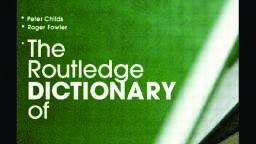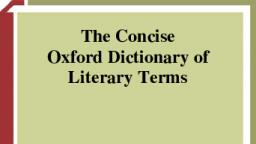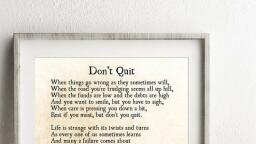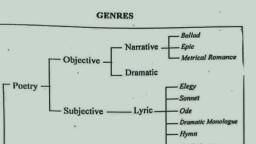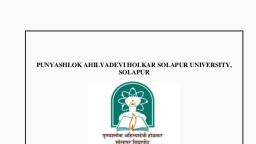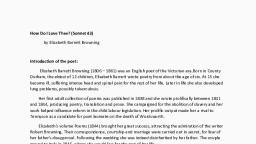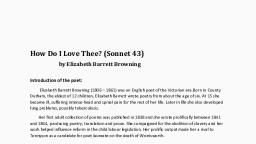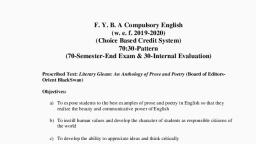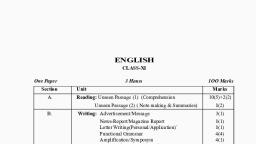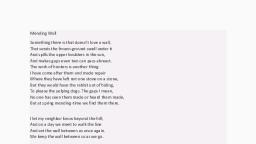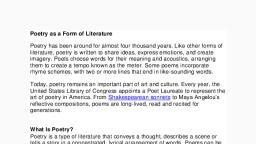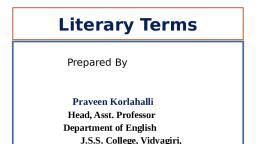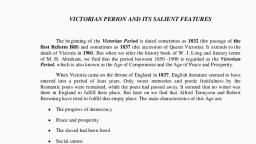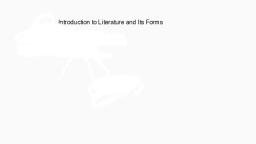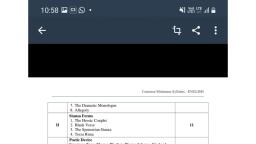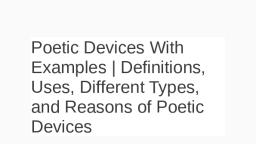Page 1 :
UNIT I INTRODUCTION TO POETRY, Structure, 1.0 Obyectives, Staty Guide, 12 Elements of Poery, Distinction between Foery and Prose, 12.2 Poeiry is a Metrical Compostion, 1.23 Poery, an Organised Form, 121, 12.4, 1.25 Rhyme, 125, Allieration. Assorance, Stara, 1.28 Figures of Speech, Fonns of Poctry, 1.2.7, 1.3, The Ballad, The Sonnet, The Epic, The Dramatic Monologue, 13.2, 33, 1.3.4, 13.5, 1.4 Giossary, 1.5 Comprehension Exercises, 1.6 Summing Up, The Lyric, the Elegy, and the Ode, 1.0, OBJECTIVES, This unit deals with the question."What is Poetry?" and discusses the various elements of, Poery. The Unıt also gives a brief description of the different verse forms. Af the end of, pur study of this unit, you will be able to :, recognise how a poem "works", describe the techniques of Poetry, read a poem with an understanding of the principles of versification;, describ. vocabulary of literary terms such as prosody, diction, imagery etc., 1.1, STUDY GUIDE, The omprehension exercises given at the end of the unit will help you to discern the, parterns of words in any poem that will add to your in-depth understanding of the poems in, you: course. We have marked the difficult words. Please turn to Section !.4 (Glossary) to, understand them., ELEMENTS OF POETRY, We all recognise the difference between the way we speak and the way poetry is written or, read. Where does this difference ie? It is more in the organisation of words than in the, language that is used, that we discern the difference. The organisation of words in poetry does, not always correspond to that in the spoken language or to that in the language of the regular, re..ding matter with which we are familiar., This brings us to the question of distinction between prose and poetry., 1.2.1, Distinction between Poetry and Prose, Iustead of asking ourselves what poetry is. let us think about what poetry is not., Scanned by CamScanner
Page 2 :
Pet s t prese. Have you ever thought about the significance of this simple truth?, Yu e ae Uhat all wnongs can be breadiy classified under these two categories-prose, AN. The essencal difference between the two is that prose is the vehicle of reason, ile pery s he vebicie of emotion. This in no way suggests that prose excludes emotion, and ey eciudes reason. We all know that scientific discoveries, philosophical discourses., tegal eapositioe and iterary theones employ the medium of prose and not of poetry. It is so, ecsuse all such wntings demand reasoned argument and unambiguity in expression, which, can be best actieved only in prose., Bet pvets do me believe exclusively in the primacy of reason. A poet is a person of strong, feelings and teenly develeged sensibility. He is imaginative and has an intuitive response, all than he sees and hears He sees objects not merely as sense impressions (as the eye, of, pevives them, n discem is existence in a worid beyond the reach of his senses. For example, a rose is a, Ose te all of us, bet to the pet contemplating it, it becomes something more than a rose., Like anyone of us, he also seces the rose with his eves, smells its fragrance, discems its, ceicur and share and gets pleasurable excitemen. But the appea! of the rose does not stop, here. goes beyond bis sense and inteliect to evoke in him an emotional response to its, beauty., ith the power of bis imagination, he looks beyond the perceived object, emustion, Wondsworth, cne of the greatest English poets, wrote these lines about a person who is, insensiive to nature's beauty., "A primrose by a river's brim,, A yellow primrose was to him., And it was nothing more", But to Wordsworth. the same primrose is more than a little er; it evokes in him feelings, of great joy and e.uitation. This capacity for emotional response - what is knowr as, sensibility - is related to his imaginative perceprion to look into the inner life or spirit of, the object perceived (e.g. the rose). In other words, the poet creates a new world out of the, object perceiveed-a world that exists within his idea, his imagination and his vision., Poetry enables bim to give expression to this newly created world of his imagination that, lies beyond the senses. But you must remember that the poet's world is not a dream world; it, is as much roted in the perceivable world except that most of us do not have the poetic, capubility to express our feelings and emotions on seeing something as beautiful as a rose., All poetry is a succession of experiences-sights and sounds, thoughts, images and, emocons. This, in essence, is the fundamental difference between prose and poe try: while, prose limits itself largely to the intellectual and the rational, poetry goes deeper to dwell, upon the imaginary and the visionary perceptions. The empirical and the tangible reality, is the domain of prose, while the suprasensible and the intangible fall within the sphere of, • pret eater, se - intillectnal, ad vational, Pretiy t Music, 1.2.2, Poetry is a Metrical Composition, axpenthent, ble- Matinial, Poetry pleases us. How?, Poetry gives us pleasure because of its relationship to music. Just as we respond to the, rhythm in music, we are swayed by the rhythmic effect of the sound pattems in poetry., Pery expresses a rich imaginative awareness of experience through meaning, sound and, Thythm. These three components (meaning, sound and rhythm) essentially give põetry its, musical quality. Poetry uses words which are expressions of both musical sound and, meaningful speech. The language of poetry is the most expressive rhythmic language., Rhythm in English is based on recurrence of strong and weak syllables in a pattern. In Rhytun., poetry, it signifies the tempo and fluctuation of movement. It is here that poetry comes, close to, Prse, semcikle, sensible, Music has the quality to appeal to the soul or spirit in us. It does not stop with producing, pleasurei le excitement at the sensory level, but creates certain vibrations within us,, wherefore we experience a sense of harmony in tune with the musical harmony. Poetry is, analogous to music stirring the vital being in us and producing elevated excitement., gible, Scanned by CamScanner
Page 3 :
1.23 Poetry, an Organised Form, lomdituon if grat nel, Introduction to Poetry, Poetry has a highly organised fonn, which is determined by the exigencles of metre and, thyme, We use language in our ordinary speech for purposes of communication. The, Language that we use expresses ideas and feelings necessary to our daily'routine and whenever, we wish to infuse vital power into these words, we do so by a change in intonation of the, voice or by an emphasis on cerain key words. When you look at verse written on a page,, you recognise at once that verse with its line-endings has a regular form. Poetry uses words, in an organised arrangement or pattern to express feelings, sensations, broad mental, impressions and visions which are often intellectually difficult to express., 1.2.4, Metre, Metre is important to poetry and therefore, we have to know something about me tre in, poetry. What is metre? It is the arrangement of words into patterns based on strong and weak, beats in a line of poetry. A knowledge of metre cannot make you a poet, but it will enable, you to appreciate some aspects of poetry better,, When you listen to a sentence in English, you hear the prominent syllables (words or parts, of words uttered with greater effort or breath force) recurring at regular intervals. A syllable is v, a word or a part of a word which contains a vowel sound (or a consonant acting as a vowel)., Similarly in English verse, we have stressed (accented) and unstressed syllables occuring, according to a pattem. This is called metre. In most English poetry, we have a fixed number, of stressed syllables in a line and also a fixed number of unstressed syllables coming before, or after each stressed syllable. (We shall indicate a sressed syllable by the mark'and an, unstressed syllable byv). For example, take a word 'defence'. We have to pronounce the, word with a weak accent on de and a strong accent on fence and thus the word can be, marked děfénce. In poetry, the basic rhythm is established by regular pattem of accents-, cither by altemating weak and strong syllables or by sing two weak syllables with each, strong syllable-, sealla ble - contaunre, vowel cound or, a omenant acting., a vowrl., (accented), Stressed', uustrersed c (Unaeeantel, dé fénie, i) juiriu, or, ii), For exarmple, Muter - sterel and Unstresed, sylables, murdings to O the pattam., Rythin -, And and' morementvals, i) Lét her líve to cám her dínners., at., ii) Táke her úp/ténděrlý., of, A group consisting of a strong and one or more weak syllables is usually called a foot. We, can say that the foot in (i) has the pattern 'strong-weak' and in (ii) 'strong-weak-weak'. A, foot can thus be defined as a unit consisting of one strong syllable and one or more weak, syllables., Stumay - weak, sMong- weak- week, Metre in poetry consists of one or more feet in a line and the pattern can be described on the, basis of the number of fet in a line. Thus,, strong one, werk eyllfele, a frot., Fost- a, One-fost line, %3D, monometer, is called, two-feet line, dimeter, %3D, three-feet line, trimeter, four-feet line, weak, %3D, tetrameter, five-feet line, pentameter, 2) shingl -uresk -, (6) hexa-, weak., (7) hepta- and (8) octameter, The name given for the foot 'weak-strong' is the 'iamb'. This is the most common pattern, in English poetry., In mb -, the frot wek-, strong is, name gwen for, "Tiger, tiger burning bright" is an example of a line of 'strong-weak' feet. When the pattern, is 'strong-weak' it is called trochaic metre. If the foot has the pattem 'weak-weak-strong', (two unstressed followed by one stressed), it is called an anapaest., Pechaie. strong -eak metre the Tanlo., Anapest - wak. ntalk -, Like the leáves/ of the for / est when summer is green, This is anapaestic tetrameter., meter, Scanned by CamScanner
Page 5 :
If the order is reversed, i.e. one stressed syllable is followed by two unstressed syllables, the, foot is called a dactyl)., Cánnon to right or tňem,, Câmion vlen of them, (Tennyson), A poet does not use just one kind of foot in a pocm, but significant variations are used lest, the effect should be spoiled through repetitions of the same metre. But one kind of foot is, usually dominant and this pattem, usually established at the beginning of a stanza, will, reassert itself later. It is metre which determines the rhythm and distinguishes verse from, prose, In prose there is no regular pattern in the arrangement of stressed and unstressed, Dactyl- shing, -wea.mak, Rhythm, Rhythm, as we have said, is the term used to refer to sounds or movements occurring at, regular intervals of time. English rhythm is based on the pattern of stressed syllables, occurring at roughly equal intervals. Sometimes there is a distinct pause at the end of a line., Such a line is known as an end-stopped line. When the sense is carried on to the next line, it, is called a run-on-line., Run., sanse i camid n, énd-etepped hine- distürt, - ow lime- wher the, 1.2.5, Rhyme, Rhyme is the repetition of identical sounds at the end of lines. Though rhythm is basic to, poetry rhyme is not. Poets use rhyme for three major purposes:, to the next line., 1) The recurence of the same sequence of sounds has a pleasing effect; it fulfils the, readers' expectancy;, 2) It also marks the end of a line; and, 3) It binds the lines together and thus achieves unity., Perfect rhyme, Identical consonant sounds follow identical stressed vowel sounds. Perfect rhymes involve, identity of sounds not of spellings (e.g.) meet-fleet, fix-sticks)., Masculine rhyme, The final syllables are stressed and identical in sound, beginning with the last stressed vowel, (e.g.) stark-mark, support-report., Feminine rhy me, Stressed rhyming syllables followed by unstressed rhyming ones (e.g.) flatter-batter., End rhyme, Rhyming words are at the end of a line., Internal rhyme, Rhyming words within the line (e.g.), 'to dance to flutes, to dance to lutes'., 1.2.6, Alliteration, Assonance, Repetition of identical consonant sounds at the beginning of the stressed syllables (e.g.), "Whereat, with blade, with bloody, blameful blade,, He bravely broached his boiling, bloody breast.", "Bring me my bow of burning gold", "After life's fitful fever", [Shakespeare], Assonance, Identical yowels in stressed syllables preceded or followed by differing consonant sounds in, words in proximity. If 'tide' and 'hide' are rhymes, 'tide' and 'mine' have assonance., Scanned by CamScanner




